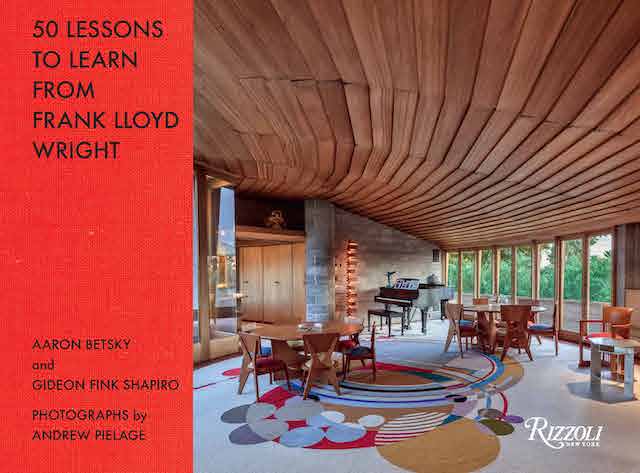50 Lessons to Learn from Frank Lloyd Wright
50 Lessons to Learn from Frank Lloyd Wright: Break the Box and Other Design IdeasAaron Betsky and Gideon Fink Shapiro, Photographs by Andrew PielageRizzoli, April 2021Hardcover | 9-1/2 x 7 inches | 248 pages | # illustrations | English | ISBN: 9780847865369 | $32.50PUBLISHER'S DESCRIPTION:Unlike recent books focusing on Wright’s tumultuous personal life and the Taliesin Fellowship, and equally unlike certain works that paint Wright as a mythical hero or genius, this handsome and valuable volume aims to reveal some of the design tools Wright used to create exceptional architecture, interiors, and landscapes—and how we may glean insight from an American master and find inspiration for the thoughtful design of our own homes. By means of succinct examples, pithy texts by noted architecture experts Aaron Betsky and Gideon Fink Shapiro, and evocative visuals provided by photographer Andrew Pielage, they share fifty lessons, or "learning points," with an eye to Wright-designed houses and interiors, ranging from "Let Nature Inspire You," "Screen, Don’t Close," and "Embroider Rooms with Textiles," to "Look to Asia," "Design for Resilience" and "Balance the Whole." Each lesson is accompanied by color photographs, original Wright drawings, newly commissioned diagrams, thoughtful analysis by the authors, and pearls of wisdom gathered from the master's trove of writings on architecture and design. Beyond specific lessons, this volume offers an informal yet richly detailed introduction to this seminal figure, world-famous for his romantic Fallingwater and magical Guggenheim Museum, and will be of much interest to the budding architecture enthusiast as well as to the interior designer, to those seeking ideas for their own homes, and to fans of Frank Lloyd Wright looking for just the right book.Aaron Betsky is a critic, curator, educator, lecturer, and author of more than a dozen books. He is director of Architecture + Design at Virginia Tech. Previously, he was dean of the Frank Lloyd Wright School of Architecture and, after independence, president of the School of Architecture at Taliesin. Gideon Fink Shapiro is an architecture and design writer based in New York and co-author of The New Residential Colleges at Yale: A Conversation Across Time. Andrew Pielage is an internationally published architectural and travel photographer based in Phoenix, Arizona, on a mission to photograph all remaining Frank Lloyd Wright designs. His work has appeared in such publications as National Geographic Traveler and Vanity Fair.REFERRAL LINKS: dDAB COMMENTARY:There is something inevitable about this book. Aaron Betsky is a prolific architecture critic who weighs in on just about every issue that makes architecture headlines, something he did even as his day job shifted to heading the School of Architecture at Taliesin (formerly the Frank Lloyd Wright School of Architecture, now simply The School of Architecture), a position he served from 2015 to 2020, and something he still does as director of Virginia Tech’s School of Architecture + Design in the College of Architecture and Urban Studies. It would be hard for any architect whose office and home alternated between Taliesin in Wisconsin and Taliesin West in Arizona to not be influenced by Wright's architecture, but for someone like Betsky it means a book about Wright was bound to happen. For 50 Lessons to Learn from Frank Lloyd Wright, Betsky teamed up with fellow writer Gideon Fink Shapiro and photographer Andrew Pielage to craft a handsome little coffee table book that tries to "show that Wright is still relevant," they write in the preface, "and that there's a lot to learn from his work without getting bogged down in his cult of personality."Forty-nine of the fifty lessons are organized into seven thematic chapters with paired terms: "Influences and Inspiration," "Site and Landscape," "Design and Society," "Space and Experience," "Composition and Movement," "Building and Body," and "Abstraction and Cosmos." Separate from these chapters is the first of the numbered lessons: "Break the box," which could easily fit inside one or two of the chapters but takes on special significance on its own at the beginning of the book. For Betsky and Shapiro, breaking out of the book is physical, with planes slipping and sliding past each other "so that light and air can come into the corner," but also symbolic, with boxes "limit[ing] our dreams and aspirations." Though not explicit in this lesson, perhaps Wright's greatest impact on architecture — in the widest sense of the word, not just capital-A architecture — was his opening up of domestic spaces previously compartmentalized; his influence is felt every time I see interior partitions knocked down (boxes literally broken) during a home improvement TV show, as inevitably happens in just about every one of them.Racking my brain to ascertain the first lesson I learned from Wright, I think back to high school, when I was fortunate enough in my subur

Aaron Betsky and Gideon Fink Shapiro, Photographs by Andrew Pielage
Rizzoli, April 2021
Hardcover | 9-1/2 x 7 inches | 248 pages | # illustrations | English | ISBN: 9780847865369 | $32.50
PUBLISHER'S DESCRIPTION:
REFERRAL LINKS:
SPREADS:









